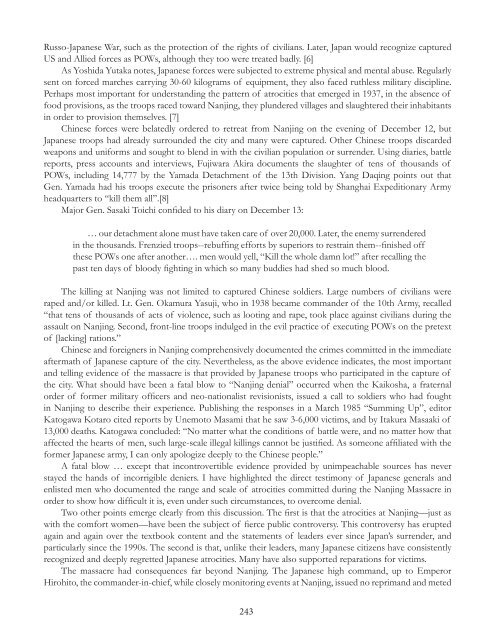Download - Canada ALPHA
Download - Canada ALPHA
Download - Canada ALPHA
You also want an ePaper? Increase the reach of your titles
YUMPU automatically turns print PDFs into web optimized ePapers that Google loves.
Russo-Japanese War, such as the protection of the rights of civilians. Later, Japan would recognize captured<br />
US and Allied forces as POWs, although they too were treated badly. [6]<br />
As Yoshida Yutaka notes, Japanese forces were subjected to extreme physical and mental abuse. Regularly<br />
sent on forced marches carrying 30-60 kilograms of equipment, they also faced ruthless military discipline.<br />
Perhaps most important for understanding the pattern of atrocities that emerged in 1937, in the absence of<br />
food provisions, as the troops raced toward Nanjing, they plundered villages and slaughtered their inhabitants<br />
in order to provision themselves. [7]<br />
Chinese forces were belatedly ordered to retreat from Nanjing on the evening of December 12, but<br />
Japanese troops had already surrounded the city and many were captured. Other Chinese troops discarded<br />
weapons and uniforms and sought to blend in with the civilian population or surrender. Using diaries, battle<br />
reports, press accounts and interviews, Fujiwara Akira documents the slaughter of tens of thousands of<br />
POWs, including 14,777 by the Yamada Detachment of the 13th Division. Yang Daqing points out that<br />
Gen. Yamada had his troops execute the prisoners after twice being told by Shanghai Expeditionary Army<br />
headquarters to “kill them all”.[8]<br />
Major Gen. Sasaki Toichi confi ded to his diary on December 13:<br />
… our detachment alone must have taken care of over 20,000. Later, the enemy surrendered<br />
in the thousands. Frenzied troops--rebuffi ng efforts by superiors to restrain them--fi nished off<br />
these POWs one after another…. men would yell, “Kill the whole damn lot!” after recalling the<br />
past ten days of bloody fi ghting in which so many buddies had shed so much blood.<br />
The killing at Nanjing was not limited to captured Chinese soldiers. Large numbers of civilians were<br />
raped and/or killed. Lt. Gen. Okamura Yasuji, who in 1938 became commander of the 10th Army, recalled<br />
“that tens of thousands of acts of violence, such as looting and rape, took place against civilians during the<br />
assault on Nanjing. Second, front-line troops indulged in the evil practice of executing POWs on the pretext<br />
of [lacking] rations.”<br />
Chinese and foreigners in Nanjing comprehensively documented the crimes committed in the immediate<br />
aftermath of Japanese capture of the city. Nevertheless, as the above evidence indicates, the most important<br />
and telling evidence of the massacre is that provided by Japanese troops who participated in the capture of<br />
the city. What should have been a fatal blow to “Nanjing denial” occurred when the Kaikosha, a fraternal<br />
order of former military offi cers and neo-nationalist revisionists, issued a call to soldiers who had fought<br />
in Nanjing to describe their experience. Publishing the responses in a March 1985 “Summing Up”, editor<br />
Katogawa Kotaro cited reports by Unemoto Masami that he saw 3-6,000 victims, and by Itakura Masaaki of<br />
13,000 deaths. Katogawa concluded: “No matter what the conditions of battle were, and no matter how that<br />
affected the hearts of men, such large-scale illegal killings cannot be justifi ed. As someone affi liated with the<br />
former Japanese army, I can only apologize deeply to the Chinese people.”<br />
A fatal blow … except that incontrovertible evidence provided by unimpeachable sources has never<br />
stayed the hands of incorrigible deniers. I have highlighted the direct testimony of Japanese generals and<br />
enlisted men who documented the range and scale of atrocities committed during the Nanjing Massacre in<br />
order to show how diffi cult it is, even under such circumstances, to overcome denial.<br />
Two other points emerge clearly from this discussion. The fi rst is that the atrocities at Nanjing—just as<br />
with the comfort women—have been the subject of fi erce public controversy. This controversy has erupted<br />
again and again over the textbook content and the statements of leaders ever since Japan’s surrender, and<br />
particularly since the 1990s. The second is that, unlike their leaders, many Japanese citizens have consistently<br />
recognized and deeply regretted Japanese atrocities. Many have also supported reparations for victims.<br />
The massacre had consequences far beyond Nanjing. The Japanese high command, up to Emperor<br />
Hirohito, the commander-in-chief, while closely monitoring events at Nanjing, issued no reprimand and meted<br />
243


